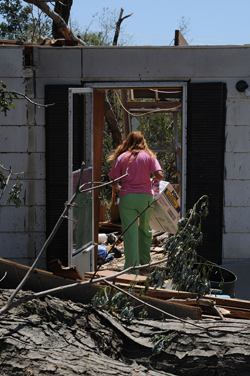
| Vol.
XXIII No.
5 May / June 2011 |
| contents |
| Printable Version |
Preventing Utter Devastation in
Tornado/Hurricane Prone Areas
The utter destruction of homes and other buildings in Mississippi and other southern states, with an associated loss of lives and businesses, reopens an old question of building codes and methods as well as materials used in construction.
Most of the devastation was experienced in wooden buildings usually constructed of 2x4 studs and plywood nailed together. It was interesting that most concrete, even cinder block buildings suffered much less, if any damage. More solid, hopefully precast concrete buildings would provide safer environments, prevent much loss of life, and also assure better maintenance of infrastructure and services. While many houses have or had concrete basements, there were others that were built on simple concrete foundation pads. In my experience, the cost of a concrete building is usually equal to that of a wooden building, even though the material and form costs are higher.
At the same time, the cost of insurance should be lower as the insurance risk is reduced. Not only does traditional American wooden building construction pose a huge storm damage possibility, but also fire, tornadoes, and other risks. The added costs of these risks would easily cover additional construction costs, if any.
In fact, wooden houses on average have significantly higher lifetime maintenance costs than the same buildings or houses built of precast concrete. Lifetime ownership costs should therefore be considered in choosing building materials.
Some owners may prefer wooden walls, particularly in the interior. This is easily and cheaply accomplished and should cost less than the brick or tile facing many builders use for exterior facing to make buildings look more solid.
A formal study of life cycle costs, including maintenance and insurance of standard housing and commercial buildings, would help decision makers choose materials and methods of construction more widely, and hopefully greatly reduce U.S. housing ownership costs. In fact, it may be interesting to develop standard designs and construction costs, not just of material quantity but of standard building units. Foreign experience shows that as forms, etc. constitute a major part of construction costs, standardizing such costs could pay off handsomely. Similarly, utilities could readily be incorporated into the designs and casting forms. There is an urgent need for safer housing and buildings in general and MIT could and should play an important leadership role in this issue.
In Japan, for example, major academic institutions play a significant role in developing earthquake-proof building methods and designs and the codes applied in regulating construction material, standards, and designs. Precast, reinforced concrete building methods have advanced greatly in recent years and even though the material-to-labor costs are higher, total costs should be and are comparable. Similarly, completion times are usually shorter. Obviously America has an abundance of lumber and the lumber industry is both important and influential, but wooden building construction is very labor intensive and quality standards are hard to define and control.
There is an urgent need for a definitive study of comparative cost for construction, maintenance, and insurance over the life of buildings, including all hazard and risk costs. Such research could readily become a national guideline for the construction and home insurance industry.
| Back to top | |
| Send your comments |
| home this issue archives editorial board contact us faculty website |
